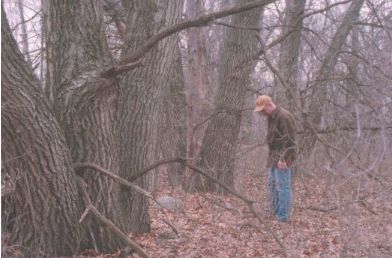
You found a beautiful patch of oak trees where the forest floor is turned upside down by deer feeding on acorns. Yet no deer show up when you’re in your tree stand.

Deer hunters must scout before season as well as all
through season to keep up on the ever-changing
conditions that influence where deer choose to feed.
Deer love to eat acorns but even acorns won't draw them in if there's nowhere for the deer to hide. While the forest here has massive, mature oaks that bear tons of nuts, it’s too open for deer to feel comfortable in during daylight hours. Hunters used to hunting deer around farmland think of fields as feeding areas and woods as bedding areas.
This is true, but mature woods with an open understory (underlying layer of vegetation is not the bedding area in this situation—it’s the feeding area.
Think of open woods as a clover field; deer go there to feed under the cover of darkness. Hunt the edges where mature oak meets dense stands of heavy cover. Fingers, points, and bays where one type of cover extends into the other are better yet.
You hang your deer stand in your favorite oak patch where you’ve had luck in previous years. But every day the woods are deathly quiet.

Be mobile! Acorn crops vary greatly from one year to the next. In fact, all members of the red oak family are only capable of bearing nuts every two years (if conditions are favorable). White oaks can bear every year, but many natural factors affect the quantity of nuts they produce, such as precipitation and spring frosts. Keep scouting all through season to find where deer are feeding now. Deer are likely to return in the evening to the spot where they fed the previous night, or very close to it.
Or they may be leaving the area headed to cover the next morning. Set up to hunt the same evening you find the fresh sign, or the very next morning, with a minimum disturbance. Here’s where lightweight, climbing treestands, portable ground blinds, camo cloth, or improvised hunting blinds made from available cover come into play. Leaving to enter the area again the next day and spending an hour to set up a hang-on tree stand might not be as effective.
You hunt deer trails passing from brushy bedding areas into oak forest, but all that come by are does.

Look for parallel movement. When hunting the rut, or just before the rut, bucks cruise the edges where oak and brush meet, hoping to cut the trail of a hot doe that has passed from one type of cover to the next. Faint trails can be found paralleling the edges, mostly on the brushy side. (At night bucks can easily cruise open oak forest without the need to follow a trail.) Don’t expect to a find long, continuous, well-beaten trail paralleling the edge. Instead you will find short stretches that make up a trail system within a travel corridor.
Each noticeable stretch will only be a few yards long where the lay of the land constricts game to pass over the same spot for a short ways. The corridor still runs along the entire edge though. This strategy can be effective for hunting big woods bucks throughout the day—not just morning and evening.
Tip: How Well do You Know the Pre-Rut? Take this quiz and find out
Your well-selected hunting stand sites just don’t pay off.
Try still-hunting. This allows you to hunt more area, and to scout for fresh deer sign so you can quickly set up for their return. Parallel the edge like bucks do, but stay on the open forest side where you can move quietly. Hug the edge; look into the brush not just down the line, and hunt morning and evening when deer are also moving. The key is to move slow and stop often. When scouting for deer sign while still-hunting, do the scouting last; that is stop to peer into the brush and scan the open woods, and then look down for sign. I can’t count how many times I’ve been engrossed with the fresh sign at my feet only to look up to see white flags bounding away.
Tip: Looking for more info about hunting deer, acorns and scouting? Check out Bass Pro 1Source keyword acorns.
- 50991 views

